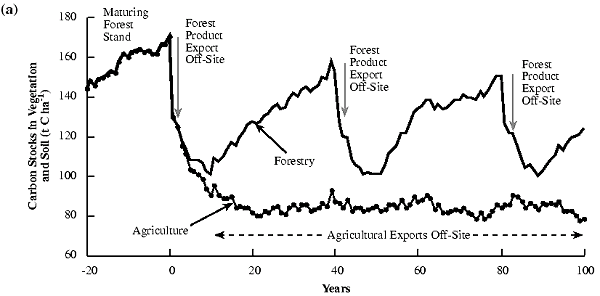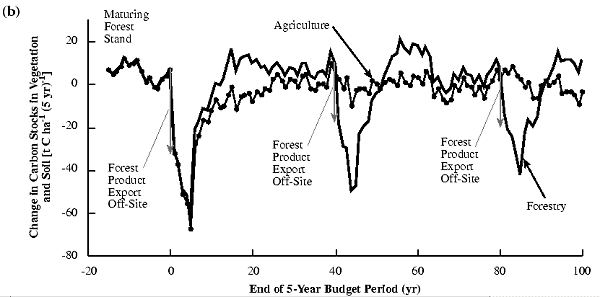|
1.3.3. The Future of the Terrestrial Carbon Sink
Table 1-2 illustrates the considerable uncertainty
about the relative importance of the present global oceanic and terrestrial
sinks in acting as negative feedbacks on the rate of CO2 increase. These sinks
may also change in the future as atmospheric CO2 continues to rise. The question
therefore arises whether these feedbacks may reach some limit, so that no additional
carbon can be stored on land. This possibility would imply that the airborne
fraction of emissions would increase more rapidly in the future than at present.
How long the current carbon sink capacity of the terrestrial biosphere is likely
to be maintained into the future is a matter of conjecture; several hypotheses
proposed as the basis for quantitative explanation are discussed here. Consideration
of the nature of the uncertainties for such projections is essential, however.
The time scale of our immediate concerns with respect to the biospheric sink
as a possible means of reducing the impact of GHG emissions is considered to
be several decades, but longer time scales may become relevant if emissions
of GHGs continue to rise. Projections of future sources and sinks of carbon
in terrestrial ecosystems depend on multiple aspects of the future environment:
climate (temperature, precipitation, humidity, and radiation), atmospheric CO2
concentration, nutrient deposition, land use, and ecosystem management (Thompson
et al., 1996). Projections of most of these variables into the medium term are
highly uncertain, particularly with respect to their future spatial patterns.
The regional distribution of ecosystems is an important factor influencing the
overall sink capacity. Therefore, improved regional scenarios for human land
use are as important for better sink strength projections as they are for better
regional climate scenarios.
We may assume that the total capacity for carbon storage in terrestrial ecosystems
has an upper limit as a result of mechanical and physiological constraints on
the amount of aboveground biomass and physiochemical constraints on the amount
of carbon that can be held in soils. These fundamental limits are presently
not known in quantitative terms, but it does not seem very likely that they
will become of importance within a few decades. Over the past 10,000 years-since
the last glaciation-carbon has accumulated in the boreal and north temperate
forest ecosystems very largely as transfer from the atmosphere, via vegetation,
to the soil organic carbon (SOC) pool. Experimental addition of nutrients has
demonstrated the large capacity of these ecosystems for additional tree growth,
production of detritus, and SOC. We may therefore conclude that this accumulation
of carbon has been constrained since the retreat of the ice by the slow concurrent
accumulation of nutrients, particularly nitrogen, in the ecosystem. The present
small size of trees in the boreal region and their low nitrogen content suggest
that the capacity of the system to store carbon will not by itself limit the
transfer of carbon from the atmosphere to the tree and soil pools in the immediate
future. Because an accelerated rate of climate change, as well as continuing
atmospheric inputs, may increase the availability of nitrogen, it is possible
that boreal ecosystems could increase their aboveground and below-ground carbon
storage considerably.
By contrast, moist tropical forests in general have large standing stocks of
carbon in the trees (Table 1-2). Therefore, there
may be limited scope for additional storage of carbon in the trees, although
that is less likely to be the case in sparse or secondary tropical forest (Phillips
et al., 1998). At present, moist tropical forests currently have high
NPP and NEP (Section 1.3.2.2), so it is questionable whether
this ongoing flow of carbon from the atmosphere into tropical forests can be
maintained. Significant amounts of carbon leave tropical forests in floodwaters
as particulate and dissolved organic carbon, some of which is subsequently stored
in coastal sediments (Schlesinger, 1997). This and other removals of carbon
from tropical forests may provide the opportunity for some increased uptake
from the atmosphere and transfer to storage.
Research has demonstrated that in the short term, increased photosynthesis
resulting from the rise in atmospheric CO2 concentration diminishes at higher
CO2 concentrations, whereas RA and RH increase exponentially with increasing
temperature (e.g., Boone et al., 1998; Rayment and Jarvis, 2000). Thus,
Scholes et al. (1998) have hypothesized that as atmospheric CO2 concentration
and temperature rise, the overall capacity to take up additional carbon from
the atmosphere will progressively diminish so that at some point respiration
will exceed photosynthesis and the carbon sink will become a source. Based on
these two short-term physiological response functions, Scholes (1999) evaluated
the global terrestrial carbon sink under various assumptions and concluded that
the global sink would be likely to decline from its current level of approximately
2 Gt C yr-1 and become a source within a few decades. This approach assumes
that acclimation to higher CO2 concentrations and temperatures does not occur,
that respiration is independent of photosynthesis, and that there are no feedbacks
involving nutrition between the processes. A similar, parallel, hypothesis is
that the present sink might be a temporary consequence of CO2 fertilization
that eventually will be overtaken by respiratory losses of carbon as temperature
rises and respiration "catches up." It is supposed that while photosynthesis
increases in response to the increased availability of CO2, respiration will
initially lag behind but will eventually catch up as the supply of substrate
increases or the temperature lag resulting from the thermal inertia of the oceans
declines.
To better understand the range of future terrestrial uptake of carbon, calculations
with a suite of several more detailed terrestrial biosphere models have been
based on the IPCC IS92a scenario of CO2 increase and the associated climate
change simulated by the HadCM2 General Circulation Model (GCM) (Cramer et
al., 2000). These models include integrated physiological effects of climate,
CO2, and nutrition on plant growth and plant population dynamics but include
no consideration of land-use or management effects. Stimulation of carbon uptake
as a result of enhanced uptake of soil nitrogen is included in several of the
models. For the IPCC IS92a scenario, all of the models confirm that there is
a terrestrial CO2 sink of the same order of magnitude as above that explains
the present-day overall balance; that this sink might increase in strength with
further increases in CO2 concentration; and that when the CO2 concentration
increases beyond about 500 ppmv CO2 (i.e., around 2030-2050), the rate of increase
of the sink approaches zero as the sink reaches a steady asymptote.
|


|
|
Figure 1-4: The hypothetical time-evolution
of annual-average on-site carbon stocks is given (a) for two illustrative
cases of land use, land-use change, and forestry. Both cases begin with
a common maturing forest stand that is undisturbed for the first 20
years; natural variability, as well as an overall increase, in stocks
occurs over this period. After 20 years, the forest stand is cleared
and a fraction of the forest stocks is exported off-site as forest products.
Following clearing, the land is used for forestry in one case and agriculture
in the other. In both cases, carbon stocks continue to fall immediately
following clearing due to loss of carbon from detritus and soils. In
the cases subsequent to clearing, sustainable forestry is carried out
with a 40-year stand cycle, and cultivation is carried out to yield
crops with some further loss of soil carbon. For these cases, the change
in carbon stocks over a running 5-year period (b) fluctuates due to
both variability and human activities. Carbon stocks contained in forest
and agricultural product exports off-site are not included in this illustration.
Carbon stocks in products generally have a finite lifetime (see Section
1.4.3) and can be considered in a total carbon stock inventory (see
Chapter 3).
|
A similar result has been obtained using a well-validated local-scale ecosystem
model (G'Day) that treats interactions and feedbacks between the effects of
CO2 and temperature on the pools and fluxes of carbon and nitrogen within vegetation
and soil compartments of terrestrial ecosystems (Dewar et al., 1999;
McMurtrie et al., n.d.). This model was parameterized for a boreal coniferous
forest in northern Sweden; temperature and CO2 concentration were increased
according to the IPCC IS92a scenario as above. The G'Day model indicates that,
after initiation, NPP consistently exceeds RH and the carbon sink rises to an
asymptotic maximum after about 60 years and remains there for another 50 years
without significant decline (McMurtrie et al., n.d.). The capacity at which
the sink stabilizes depends on the availability of nitrogen and the fraction
of nitrogen released in decomposition that is subsequently re-immobilized. Thus,
with appropriate feedbacks and N:C relationships considered, this model also
predicts that the carbon sink will be maintained well into the medium term.
On the other hand, sinks may disappear if climate change or deforestation would
lead to widespread tree mortality (Friend et al., 1997; Cao and Woodward, 1998;
Walker et al., 1999). Of the suite of models discussed above, one model
(HYBRID) (Friend et al., 1997) predicts a drastic decline in NPP that is primarily
the result of drought-induced die-back of tropical forest in the Amazon basin.
This finding highlights two points: First, changes in vegetation structure can
have significant effects on terrestrial carbon sinks and indeed can be as important
or more important than the physiological effects discussed above (see also Mooney
et al., 1999); second, projections of climate change impacts should be based
on a range of predictions of future regional climates. The HadCM2 GCM produces
somewhat drier climate change predictions for the Amazon than do some other
GCMs, which might well lead to different results.
These model experiments and other analyses (e.g., Walker et al., 1999)
suggest that the current global terrestrial sink will be maintained over the
short term of the next few decades unless serious mortality occurs but may diminish
toward the end of the 21st century. With the present state of knowledge, projections
beyond a few decades must be regarded as uncertain; this situation is improving
rapidly, however.
This conclusion is based on consideration of the effects of future CO2 and
climate change on the present terrestrial sink only; it does not take into account
future deforestation or possible actions taken to enhance the terrestrial sink
through land use, land-use change, and afforestation or reforestation. Higher
CO2 concentration and warmer climate may be expected to modify the effectiveness
of such activities to enhance the medium-term terrestrial sink. Improved understanding
of these effects would enable these activities to be better adapted to future
CO2 and climate conditions.
|